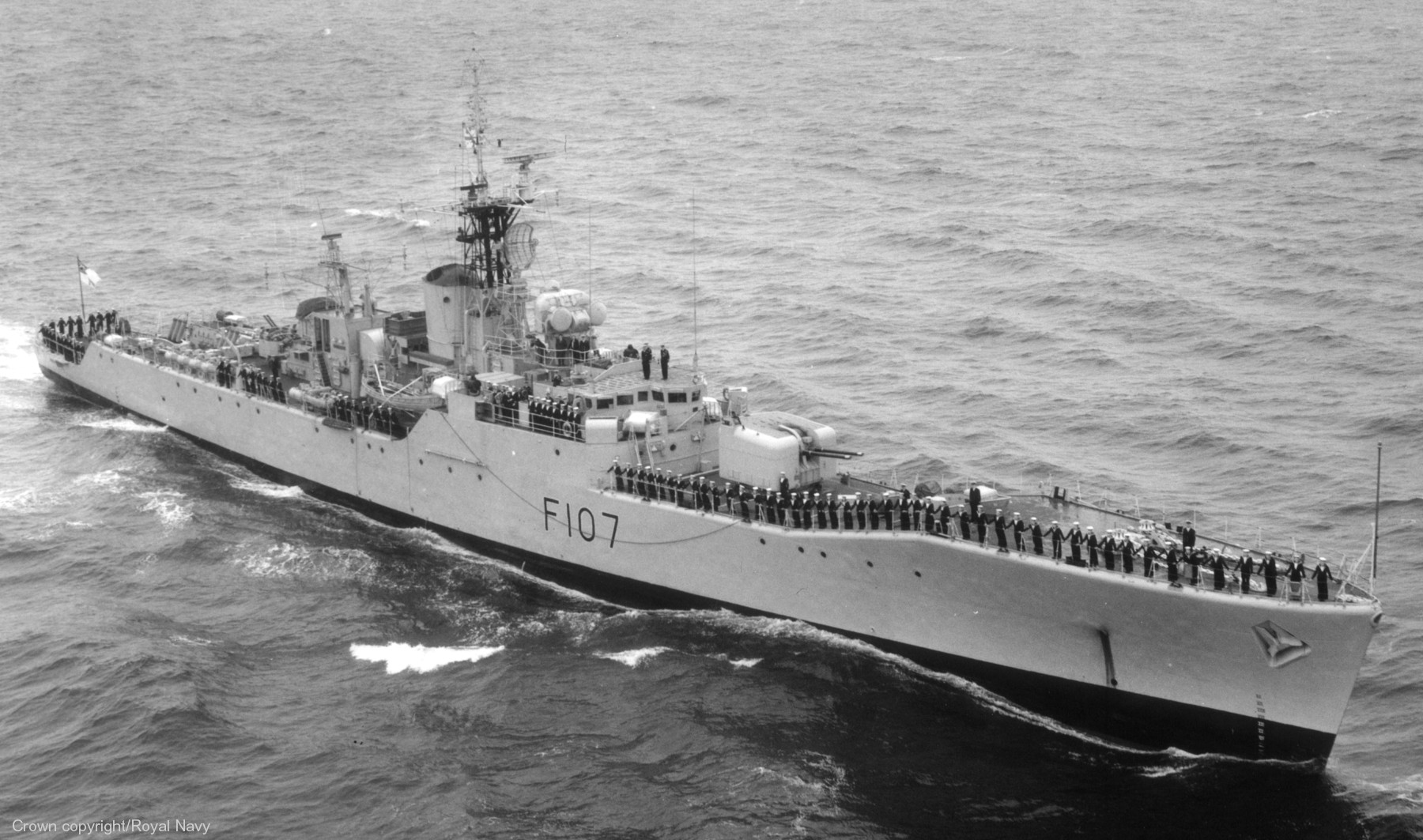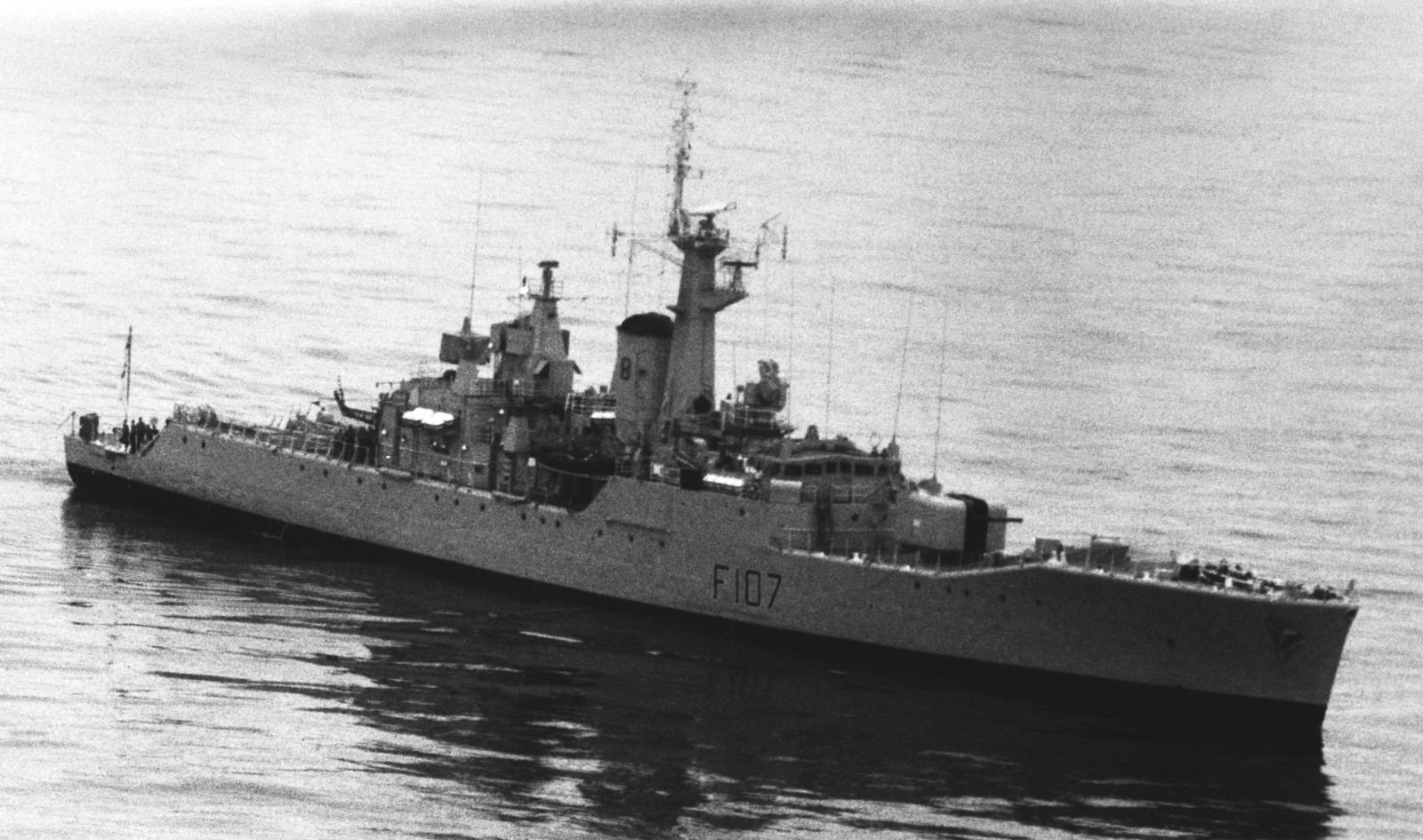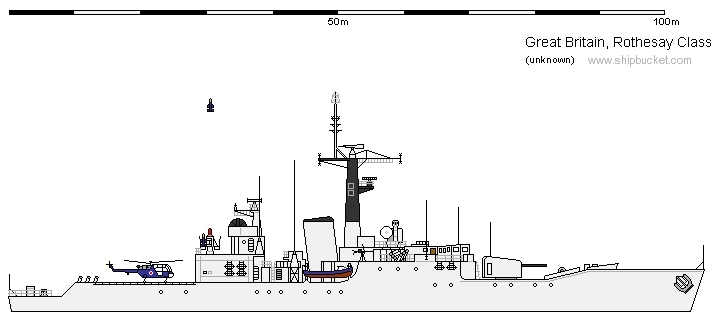|
|
|
HOME
|
US Navy -
ships
|
US Navy - air
units
|
USMC - air
units
|
International
Navies
|
Weapon Systems
|
Special Reports |
|
|
|
|
|
United Kingdom - Royal Navy Rothesay (Type 12M) class Frigate |
|
|
 |
|
|
| Ships: |
|
F 107
HMS Rothesay (1960) F 108 HMS Londonderry (1961) F 106 HMS Brighton (1961) F 101 HMS Yarmouth (1960) F 113 HMS Falmouth (1961) F 129 HMS Rhyl (1960) F 103 HMS Lowestoft (1961) F 115 HMS Berwick (1961) F 126 HMS Plymouth (1961) |
| Specifications: |
|
Length: 113 meters (370 ft)
Beam: 12
meters (41 ft)
Draft: 5,3
meters (17.3 ft)
Displacement: 2560 tons (full load)
Speed: 30
knots (56 km/h)
Range: 5200
NM (9630 km) at 12 knots (22 km/h)
Complement:
152
Propulsion:
2 x
Babcock & Wilcox boilers
2 x English Electric steam turbines (30000 shp) 2 shafts / 2 propellers Armament: 1 x Mark 6 - 4.5 inch (114 mm) twin gun 1 x Mark 7 - Bofors 40mm gun 2 x Mark 10 - LIMBO anti-submarine mortars 12 x 21 inches torpedo tubes (on some units) after modification: Displacement: 2800 tons (full load) Complement: 235 Armament: 1 x Mark 6 - 4.5 inch (114 mm) twin gun 1 x GWS-20 Sea Cat SAM missile system 2 x 20mm Oerlikon machine guns 1 x Mark 10 - LIMBO anti-submarine mortar Aviation: small flight deck and hangar for 1 helicopter (Westland Wasp HAS.1 MATCH) |
|
|
|
The Rothesay class, or Type 12M frigates were a class of frigates
serving with the Royal Navy, South African Navy (where they were
called President-class frigates) and the New Zealand Navy. The original Type 12 frigates, the Whitby class, were designed as first-rate ocean-going convoy escorts in the light of experience gained during World War II. However, such were the capabilities and potential of the design that it was deemed suitable for use as a fast fleet anti-submarine warfare escort. As such, a repeat and improved Type 12 design was prepared, known as the Type 12M (M for "modified") and called the Rothesay class after the lead ship. A total of twelve vessels were constructed, with the lead ship being laid down in 1956, two years after the last Whitby. The design was successful and popular, serving the Royal Navy and South African Navy well into the 1980s, and serving with distinction in the Falklands War. Design: The Type 12M retained the hull design of the Type 12, that allowed high cruising speed to be maintained in heavy seas, critical to the success of anti-submarine warfare in the era of the threat of the high-speed Soviet submarine. Armament and the propulsion plant remained largely unchanged. The main external differences were an enlarged raked and streamlined funnel (retroactively fitted to the Whitbys) and a modified after deckhouse, enlarged to carry the Sea Cat anti-aircraft missile launcher and its associated GWS-20 director and handling rooms as it became available. This weapon was not available originally, therefore a single 40 mm Bofors Mark 7 gun was shipped in lieu. The arrangement of the torpedo tubes was also altered in the new design, with four fixed tubes firing aft at 45° on each beam, in front of a trainable twin mounting; the reverse of the arrangement on the Whitbys. A suitable weapon was never developed for these tubes, so they remained unused, or were never fitted. Internally, electrical generation capacity was increased to handle the increasing demands created by improved ship electronics. Accommodation standards were also improved, with partial bunking and air conditioning. Such was the success of the Rothesay design that it was elaborated into the excellent general purpose Leander-class frigate, the Type 12I. Modification: Increasing submarine performance in the 1960s demanded detection and engagement of targets at a greater distance from the fleet. Detection was improved with new sonar designs such as the Type 177 search and Type 199 Variable depth. To attack targets at a greater range, the Royal Navy adopted the MATCH (Medium-range Anti-submarine Torpedo Carrying Helicopter) system. MATCH was essentially the Westland Wasp HAS.1, a lightweight navalised Westland Scout helicopter small enough to operate from the small hangar and flight deck that could be fitted to contemporary frigate designs, yet large enough to carry a pair of anti-submarine homing torpedoes (US Mark 44 or 46 types), allowing engagement of underwater targets at some distance from the parent vessel, outside the range of the shipboard Limbo anti-submarine mortars. To allow MATCH to be carried, all of the Type 12M class were modified and modernised, beginning with Rothesay from 1966 and finishing in 1972. The after superstructure was removed, along with the foremost Limbo mortar, with the well being plated over to create a small flight deck. A small hangar was constructed in front of this, on top of which the GWS-20 Sea Cat missile and director was (finally) shipped. The mainmast was replaced by an enclosed design, carrying the Type 1010 IFF antennas, and the funnel height was increased to carry the hot exhaust gasses over the taller superstructure. The electronics fit was also upgraded from the World War II era sets fitted in the Whitbys. A large, enclosed foremast replaced the short lattice, carrying the distinctive "half cheese" antennas associated with the Type 993 target indicator. The Mark 6M director was replaced with the MRS3 Mod 3 system carrying radar Type 903, the later more automated and compact 1967-73 version of MRS3 using transistor electronics and analogue computers allowing the removal of the Type 277Q height finder. Additionally, Knebworth/Corvus 3-inch countermeasures launchers were fitted on either side of the bridge, as were a pair of World War II vintage 20 mm Oerlikon guns for "policing" work (and strictly limited anti-aircraft defence). The extensive modifications of the Rothesays brought their armament and anti submarine capabilities into line with the that of the original Leander-class vessels. However the last four Leanders had Doppler full spectrum 184 sonar which gave a clearer faster-read sonar, and all the Leanders originally had long range air warning and AD capabilities and communication decks, while the Rothesays remained specialised anti submarine frigates to perform better at that single purpose. In 1978, Rothesay went into refit for two years at a cost of 33.4 million pounds Yarmouth and Plymouth completed similar refits in 1981, which included fitting 994 short range warning radar and target indicator essentially (Plessy AWS1) in the old antenna, giving faster screen data in the Rothesays' operations room. This recent refit and marginally better radar resulted in their useful despatch for use in the Falklands War. It was planned to refit HMS Rhyl, HMS Brighton, HMS Berwick and HMS Falmouth with the very long range 2031 passive towed arrays which could listen for Soviet subs at ranges of 100 miles plus. However union strikes, allegedly inspired by Communist activists, made it impossible to supply the equipment, possibly indicating how much the Soviets feared the potential of Type 12s with quiet steam plant and quiet hull sonars to run fairly fast and listen in the Arctic. In the immediate aftermath of the Falklands War Berwick and Falmouth twice deployed south for post-war patrols in 1982-3, probably ending plans to refit them as towed array frigates, as well as sister ship Rhyl which suffered mechanical failure when ordered south, and Brighton which was scrapped following the Nott Defence Review and never transferred to the standby force. Service: The Rothesays served throughout the 1960s and 1970s, with Londonderry converted into a weapons and electronics trials vessel in 1975. The successful performance of the Rothesays, and the ability they showed for sustained operation in rough North Atlantic sea conditions during the 1976 Cod War, showed that they were still relevant to the Royal Navy's main role of displaying that it had the ability to restrict Soviet submarine penetration through the Greenland-Iceland-UK Gap during the intensification of the Cold War. A more generous naval budget in the late 1970s provided by the new Prime Minister, the former RN Clerk James Callaghan, led to a provisional decision to retain the Rothesays through the 1980s with a second long refit. Plymouth, Yarmouth, and Rothesay were given full two year refits in 1978-81 with some significant updates of radar. At the beginning of 1982, many of the class had been relegated to the Standby Squadron, likely to be disposed of following the 1981 defence review, with their sister ships likely to follow suit. However, the outbreak of the Falklands War reprieved the class. Plymouth and Yarmouth were despatched with the task force, with Plymouth playing one of the most active roles of any ship. While the class proved highly seaworthy in the rough South Atlantic, particularly in the winter patrols that followed, the initial favourable assessment of their performance in the war has been revised. It is questionable whether Seacat achieved a single kill, although both Yarmouth and Plymouth claim single shared hits on Skyhawks. Plymouth's Wasp helicopter guided an AS-12 missile onto the elderly surface-running submarine ARA Santa Fe, but only after it had been prevented from diving by depth charges and torpedo hits from the destroyer HMS Antrim and from a Wessex and a Lynx helicopter. On 1 May Yarmouth and the modern Type 22 HMS Brilliant detected submarine ARA San Luis, which fired at least one German anti ship ST 4 torpedo at them, but they failed to sink the submarine in 20 hours of mortar, torpedo and depth charge attacks. In the following weeks, the limitations of the Rothesay's lack of modern sonar or link 10 data link were exposed, although Yarmouth saw the second Exocet fired and may have successfully decoyed it with chaff, if fired. Other than Brighton the rest of the class were refitted for post war service, allowing the losses and damages suffered by the Royal Navy during the conflict to be rapidly made good. Berwick and Falmouth had been retained in a state of high readiness in the standby squadron, in the expectation they would be given a further long refit, possibly as towed array frigates. Their sister Lowestoft had been tested in this role. Berwick in particular still proved useful after its short refit, giving another three years' operational service, until mid 1985. The class paid off throughout the 1980s, with Rothesay finally paying off in 1988. The demise of the class also saw the withdrawal of the Wasp helicopter, the Leanders having been upgraded to carry the Westland Lynx. source: wikipedia |
|
|
| Ships: |
|
F 101 HMS Yarmouth Builder: John Brown & Co. Ltd., Clydebank Laid down: November 29, 1957 Launched: March 23, 1959 Commissioned: March 26, 1960 Decommissioned: 1986 Fate: sunk as a target 1987 F 107 HMS Rothesay Builder: Yarrow & Co. Ltd., Glasgow Laid down: November 6, 1956 Launched: December 9, 1957 Commissioned: April 23, 1960 Decommissioned: 1988 Fate: sold for scrap F 108 HMS Londonderry Builder: JS White & Co. Ltd., Cowes, Isle of Wight Laid down: November 15, 1956 Launched: May 20, 1958 Commissioned: October 18, 1961 Decommissioned: March 29, 1984 Fate: sunk as a target June 15, 1989 F 129 HMS Rhyl Builder: HM Dockyard, Portsmouth, Hampshire Laid down: January 29, 1958 Launched: April 23, 1959 Commissioned: October 31, 1960 Decommissioned: 1982 Fate: sunk as a target in September 1985 F 126 HMS Plymouth Builder: HM Dockyard, Devonport Laid down: July 1, 1958 Launched: July 20, 1959 Commissioned: May 11, 1961 Decommissioned: April 26, 1988 Fate: scrapped in Turkey 2014 F 115 HMS Berwick Builder: Harland & Wolff Ltd., Belfast Laid down: June 16, 1958 Launched: December 15, 1959 Commissioned: June 1, 1961 Decommissioned: 1985 Fate: sunk as a target 1986 F 113 HMS Falmouth Builder: Swan Hunter & Wigham Richardson Ltd., Wallsend-on-Tyne Laid down: November 23, 1957 Launched: December 15, 1959 Commissioned: July 25, 1961 Decommissioned: 1980 / reactivated 1982 / struck 1984 Fate: sold for scrap 1989 F 103 HMS Lowestoft Builder: Alex Stephens & Sons Ltd., Linthouse, Glasgow Laid down: June 9, 1958 Launched: June 23, 1960 Commissioned: September 26, 1961 Decommissioned: 1985 Fate: sunk as a target June 16, 1986 F 106 HMS Brighton Builder: Yarrow & Co. Ltd., Glasgow Laid down: July 23, 1957 Launched: October 30, 1959 Commissioned: September 28, 1961 Decommissioned: 1981 Fate: sold for scrap 1985 |
|
images |
  |
|
|
|
|
seaforces.org
|
Royal
Navy start page
| |
